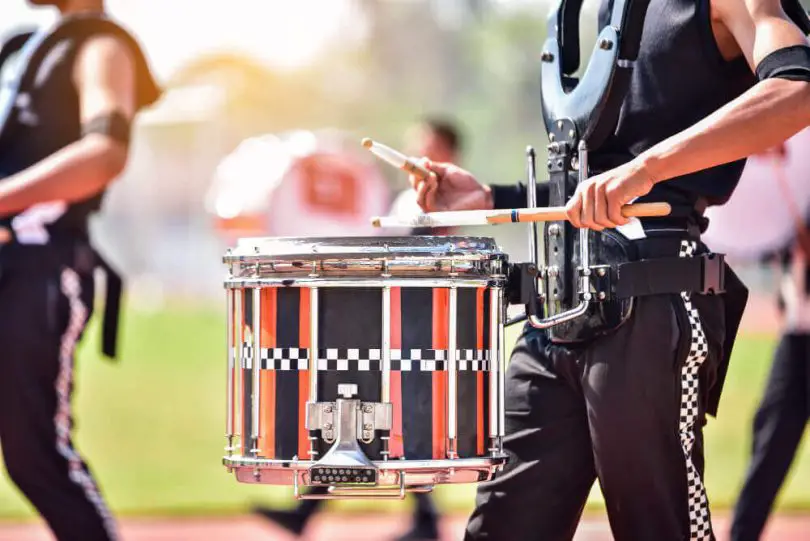Band instruments are:
- Woodwind
- Brass
- Percussion
Brass, woodwind, and percussion instruments are the most common groups of instruments in school bands, marching bands, concert bands, jazz bands, and even professional orchestras. Typical school and marching band instruments include, but are not limited to, the following:
Band instruments:
- WOODWIND
- Clarinets
- Flutes
- The saxophone is a musical instrument (Alto, Tenor, and sometimes Baritone)
- Piccolos
- Oboes
- Bassoons
BRASS:
- Trombones
- Trumpets
- Tubas
- Horns with a French accent
- Baritones
PERCUSSION
- Stringed instruments
- Bell Kit
- Drums
Bands with a wide variety of these instruments can exist. And the instruments used in each will vary widely based on the sort of band, the number of musicians, and their skill level.
The number of instruments in a normal high school band varies according on the number of kids who play them. Depending on the level of the band, whether it’s an elementary, middle, or high school band, there are a number of factors to consider.
It is common for marching bands to have a large number of instruments, as they may include hundreds of performers.
When we consider orchestras at a higher level of performance and professionalism, not only the number of instruments, but also the types of instruments and the difficulty of performing them, grows dramatically. The string section of instruments, for example, is used by orchestras and is not usually seen in school bands.
A Band Has How Many Instruments?
According to the band’s composition and size, the instruments will vary, from a high school ensemble to a professional orchestra.
The three basic categories of band instruments are woodwinds, brass, and percussion, and the number can range from 12 to 14.
Following the three sorts of instrument categories that we’ve described above, let’s take a deeper look at the most frequent types of instruments played in a school or concert band and learn more about each of them.
Woodwind Instruments
Saxophone, clarinet, oboe, flute, piccolo and bassoon are some of the more common woodwind instruments included in a band.
Sound is created when a player blows air into a mouthpiece, which causes a reed to vibrate. These little pieces are attached to a mouthpiece at the instrument’s top, which vibrates when air is breathed between the reed and the mouthpiece. It is precisely this reed vibration that distinguishes them from other forms of wind instruments. There are flutes and reed instruments, and the fundamental difference between them is the sound each instrument makes.
Flute, clarinet and saxophone are the most frequent woodwind instruments in bands, but piccolo and oboe are also common.
Despite their name, woodwind instruments aren’t built entirely of wood. However, wood was the only material utilized to create these instruments in the past, hence the name.
Different materials are now being utilized to make woodwinds: wood and silver or cane or gold or a combination of these materials. Platinum and gold are also often used. The saxophone, despite its brass construction, is classified as a woodwind since it uses a reed to produce its particular sound. For example, a typical woodwind section of a band or even an orchestra typically includes a contrabassoon, three bassoons, a bass clarinet, an English Horn, three ophios, a piccolo, and three flutes. Again, depending on whatever band we’re talking about, this might be different every time.
Generally speaking, smaller woodwinds will play higher notes, while larger instruments will play lower notes that characterize their lower tones. So, from the lowest to the highest sounding instruments, you have:
- bassoons
- clarinets
- oboes
- saxophones
- flutes
- piccolos
Bassoons
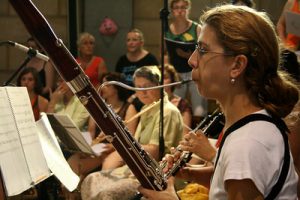
Unlike the other woodwind instruments, the bassoon has a much lower sound.
The instrument is played by holding it upright and blowing through a small, curved tube known as a bocal attached to the double reed. Their unusual bend in the pipe allows musicians to play it comfortably. After descending, the air makes a U-turn and rises as well as exits the tube from both ends of it. The bassoon is estimated to be roughly 9 feet long if it were straight.
When changing pitch on their bassoons, players use both hands to press on keys to open and close reed holes. The bassoon has a dual reed that is inserted into a circular metal mouthpiece, and you adjust the pitch by pressing on the keys with both hands. There are two to four bassoonists in an orchestra, and their sound is comparable to the cello’s. They are commonly found in orchestras. Low notes from bassoons can be heard from time to time in orchestral music, particularly in the lower harmony sections.
Saxophone

It was designed in 1846. The saxophone is a great instrument to play since it is so versatile and can be used in a wide variety of musical contexts, such as jazz bands, where it is a common sight. It’s a popular choice for saxophone players of all levels, from beginners to professionals.
Only the saxophone, which has a conical shape, is made of brass, as are all other woodwind instruments. Despite the fact that it only appears in the symphony orchestra on rare occasions is considered a member of the woodwind family.
Clarinet
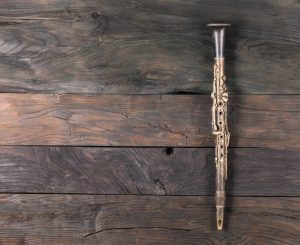
In addition to the flute and the oboe, the clarinet is a woodwind instrument that can produce a wide range of tones. As a result, it may be found in just about any genre today. The clarinet’s sound is produced by blowing air between a single reed and the mouthpiece. The player can produce a wide range of sounds by rapidly hitting metal keys with both hands.
Without its single-reed mouthpiece, one would mistake the clarinet for an oboe. It’s played like an oboe by blowing through the reed and opening and shutting the keys with your fingers.
There are a variety of clarinet sizes, including the B-flat clarinet, which is approximately 2 feet long. ‘ The clarinetist may be needed to play multiple clarinets at once in some compositions. Two to four clarinets may play both melodies and harmonies, with a distinct sound in their lower notes, which contrasts with the top section of the array, which can produce powerful and bright sounds.
Oboe
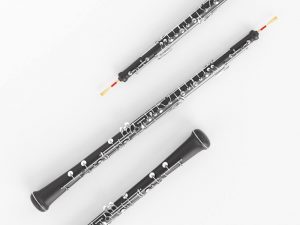
The oboe, like the clarinet, has many similarities. Both are constructed of wood and feature metal keys that can produce a wide range of tones. Unlike the clarinet, the oboe is a two-reed instrument without a mouthpiece. Reeds vibrate and produce sound when placed between a player’s lips and air is blown through them.
It takes the shape of a two-foot-long black cylindrical tube with metal keys covering the apertures. When blown into, a double reed in the mouthpiece causes it to vibrate.
The oboe’s air moves in response to the reed’s vibrations, creating sound. In order to play it, you need to hold the oboe upright, blow through the double reed with both hands, and control the pitch with the keys.
When playing in an orchestra, two to four saxophones are usually present, each capable of producing a wide variety of pitches, from haunting to velvety smooth.
Flute
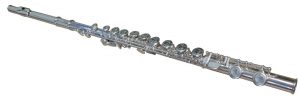
The flute is a very old woodwind instrument. The flute is known for its ability to create beautiful sounds, and you may hear it in a wide variety of musical settings, including jazz, classical, marching bands, and other genres from around the world.
It is estimated that the oldest pitch-producing instruments date back thousands of years and were built from materials such as wood, stone, clay or hollow reeds such as bamboo.
Silver, gold, and platinum are presently the most common metals used to make modern flutes. When playing a melody, a 2-foot-long common flute is typically used.
It’s one of the most popular instruments for beginners to play in a band.
The flute is played by blowing through a hole in the mouthpiece while holding it sideways. The pitch of the music changes when your fingers open and close their keys. Sound can be produced in two ways: softly and smoothly, or high and piercingly, by blowing air through the small orifice in the mouthpiece.
Piccolo
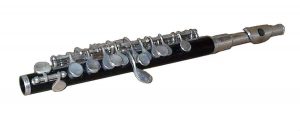
As the name suggests, piccolos are smaller flutes that can play the highest notes of all the woodwind instruments. Silver are the most common materials used. If necessary, one of the flute players in the orchestra will also play the piccolo. Drum corps and marching band music also incorporates the piccolo’s high piping sound.
What sounds are produced by each of those wind instruments?
To begin with the larger instruments, air is used to produce sound vibrations in bassoons and oboes by forcing a stream of air from a flexible strip material (metal or cane) through a double-reed.
For clarinet and saxophone (also known as “reed pipes”), the process is similar, but instead of a double-reed, we are only talking about one reed in these circumstances. The sound of a flute is produced by a restricted stream of air passing through a hole in a cylindrical tube.
For all woodwind instruments, the player’s fingers or keys immediately open or close the instrument’s holes, resulting in either greater or lower sounds depending on how much air can get through.
Brass Instruments
Trombone, Trumpet, Tuba, and French Horn are the four most common brass instruments in a band
Brass instruments include trumpets, trombones, tubas, and the French horn on occasion. Using either a slide or a valve, these instruments can be played using lip vibrations. A typical band will feature numerous trumpets, supported by trombones, and only a few tubas and French horns.
Players of the brass family use a mouthpiece with a cup or channel form to blow air into their instruments, which produces a distinctive sound. The sound is made possible by the mouthpiece by amplifying the lips’ humming. To produce higher or lower pitches, he or she can adjust the opening between his or her lips, resulting in a succession of pitches reflecting the overtone series.
Unlike its early forefathers, which were largely made of wood, tusks, horns, or shells, today’s instruments are all brass. French horns, search horns, and army bugles all have ancestry in this family of instruments.
The brass section of an orchestra or band gets its name from the fact that it is made of brass. They have the ability to play louder and farther than any other instrument in a band or orchestra.
Brass instruments are formed like long pipes that widen at the ends, giving a bell-like shape. The pipes have been bent and shaped in various ways to make them easier and more comfortable to play and hold.
In contrast to woodwind instruments, brass instruments don’t use reeds to produce sound, but instead vibrate their lips against a metal cup-shaped mouthpiece to produce sound.
The buzzing of the lips is then amplified by the mouthpiece, resulting in a sound. The majority of brass instruments have valves that look like buttons linked to their long pipes. Various sections of the pipe can be opened or closed by pressing down on the valves. In order to alter the pitch and sound, you can press various valves and also buzz your lips more or less forcefully. Among the members of this family that are frequently used in orchestras are trumpets, French horns, trombones, and tubas.
Trumpet
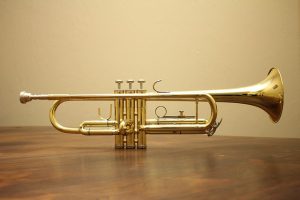
The trumpet is a powerful and versatile instrument with ancient origins. Even though it is the smallest member of its clan, its bright and vivid tones allow it to play at the highest conceivable levels. It’s extensively used around the world, and people who use it often exclaim how much fun it is to play because it allows them to perform so many different songs. Musical organizations ranging from marching bands to orchestras to jazz and blues groups, pop groups and Latin music are all examples of where this instrument is commonly employed.
It is believed that the contemporary trumpet has its roots in ancient trumpet-like instruments made of shell, pet horn, timber, or metal. There are three valves on today’s trumpet, which are joined by a slender brass pipe. The trumpet would be 6 1/2 feet long if stretched to its maximum size.
The heralds in an orchestra perform both melodies and harmony, as well as supporting the rhythm, and there are between two and four of them. To alter the pitch of the trumpet, you press down the three valves in a variety of ways while holding it flat in your mouth and pressing your lips into the mouthpiece.
The trumpet’s distinctive sound travels around 6 1/2 feet of tubing that is curled into an elongated shape for maximum efficiency. The player uses the fingers of the right hand to press the three shutoffs in various combinations to generate a wide range of pitches.
Over the course of its history, it has been used for everything from crowning monarchs and leading armies to setting off alarms and more lately bringing some cheer to parades.
Trombone
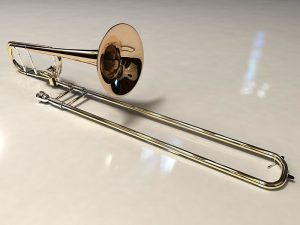
One of the trombone’s distinctive features throughout history is that it is the only brass instrument to utilize a slide to change pitch rather than a valve. Brass pipes of various lengths and diameters make up a traditional trombone. An “S” is formed by joining two U-shaped pipes at their opposite ends. The length of the pipe can be altered by sliding one pipe into another.
Trombones are usually found in orchestras in groups of three, and they play in the same style as cellos and bassoons. Most of the time, the three play harmonies in unison.
Besides being larger, the trombone’s mouthpiece produces a more pleasant sound than the trumpet’s. Trombones have a slide that is used to change the length of 9 feet of tube to achieve different pitches.
French Horn
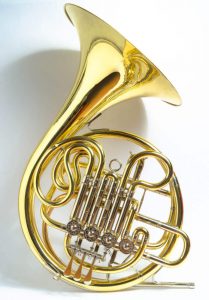
The roots of the French horn, or simply “horn,” can be traced back to when people made calls using burrowed animal horns. With such a long history, it eventually evolved into the instrument you see today, which is a big instrument with a lot of tubing and a unique register. There are a wide variety of bands and musical groups that employ it because of its adaptability.
It has a wide range of ancestors but is most closely connected to the hunting horns made in France and Germany in the 1600s in terms of design. It makes a wide range of sounds, from very loud to very soft, and from harsh and shrieking to mellow and smooth.
18 feet of tubes are wrapped around a large bell at the end of this instrument’s round shape. An orchestra should have between 2 and 8 French horns that can play harmony and rhythm tones. For best results, place your mouthpiece exactly in front of your teeth and blow into it with a buzz. You can alter the sound you make by placing your right hand in the bell while using your left hand to play the three shutoffs.
The horn, also known as the French horn, is made up of a circle of narrow tubes about 12 feet in diameter. The musician obtains numerous notes on the horn with a clean mellow tone by pressing valves with the left hand and sliding the right hand within the bell.
Tuba
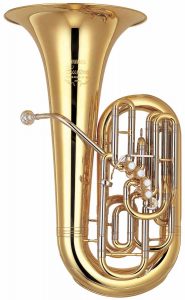
As the largest brass instrument, tubas promote the harmony of the entire band or orchestra, not just the brass family, thanks to their deep and rich tone. The tuba, like the other brasses, is a long metal tube that is curled into an oblong shape and has a large bell at the end.
Orchestras usually use only one tuba to play harmony notes; this is the instrument’s most prevalent use. It is played by sitting down and putting the instrument on your lap, with the bell facing up. Your hand to force the valves down as they blow and hum into a large mouthpiece.
In general, the longer a tuba is, the lower it will appear. The tuba is the least expensive member of the brass family, and it’s made of 16 feet of tubing. The tuba is held upright on the gamer’s lap and has three to five shutoffs. The tuba requires a lot of breath to generate sound.
Percussion Instruments
A typical percussion section comprises a band’s three most prevalent instruments.
Percussion is the final section of a band’s family of instruments. Most percussionists learn how to play a variety of instruments because this genre has so many options and each piece of music uses a different mix of instruments. Snare drums, bass drums, cymbals, xylophones, and even chimes are all members of this instrument family.
Any instrument that makes a sound when struck or scuffed is considered a percussion instrument.
There are both tuned and un-tuned percussion instruments, such as the bass drum, cymbals, and castanets, which can sound different notes depending on how they are played.
Percussion instruments keep the song moving along at a steady beat while also generating interesting sounds and adding texture and excitement.
Percussionists, unlike the majority of band and orchestra players, are able to play a wide range of instruments without being affected by the music. Instruments such as the timpani, xylophone, cymbals and triangle are some of the most commonly used percussion instruments in the orchestra. It’s no surprise that the orchestra’s percussion section is the largest.
Drums
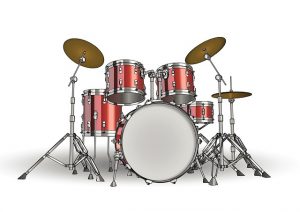
Drums are the world’s oldest musical instruments, dating back to the dawn of human civilization thousands of years ago. As long as you know how to play the drum, you can remove the Snares and get a completely different sound.
You’ll be able to play any of these percussion instruments if you have a fundamental understanding of the snare drum as well as a basic understanding of balanced principles.
Snare Drum
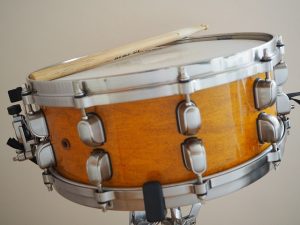
The snare drum is a small wooden or brass drum with calfskin or plastic drumheads spread across both ends of a hollow cylinder. It is possible to turn the snare drum on or off by pressing a little switch on one side of the drum.
Because the snare drum is untuned, it does not appear to have different pitches. It is often utilized in military songs and is an essential feature of every marching band. Snare drums keep the rhythm and make sounds like drumrolls. Drumsticks, mallets, or brushes are used to hit the top of the snare drum.
A Band Has How Many Instruments?
The number of instruments in a band is determined by its size and whether it is a typical school band, a marching band, or a concert band. There are usually 14 band instruments, separated into three sections:


